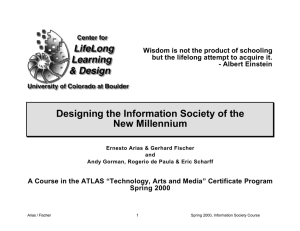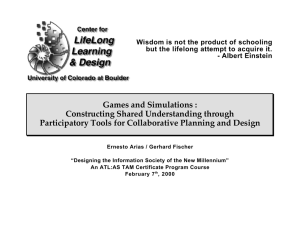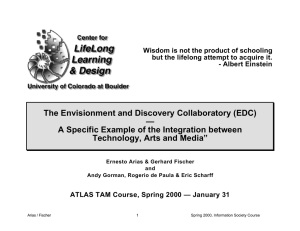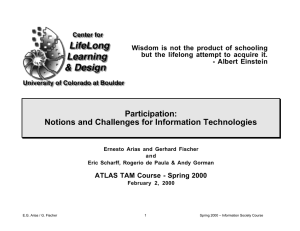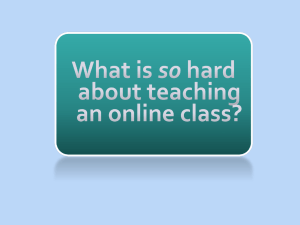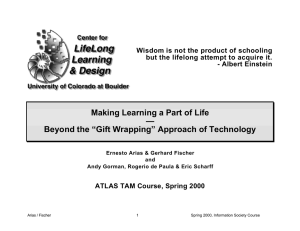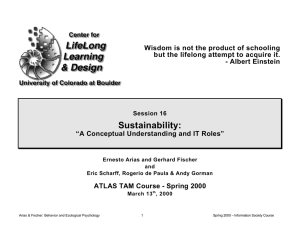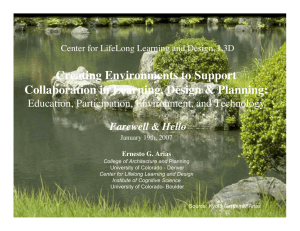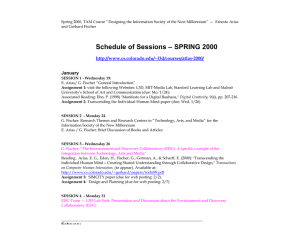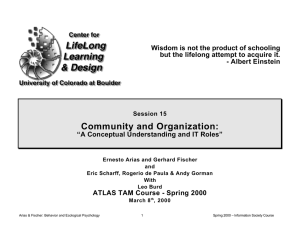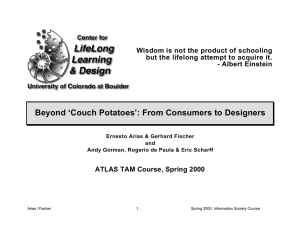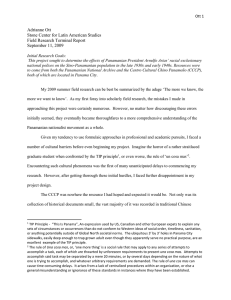Digital Bauhaus and Interesting Websites
advertisement
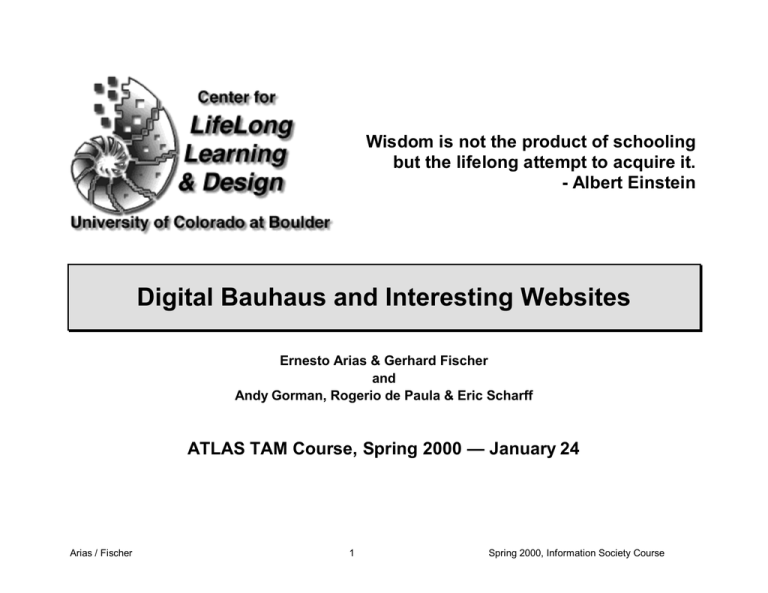
Wisdom is not the product of schooling but the lifelong attempt to acquire it. - Albert Einstein Digital Bauhaus and Interesting Websites Ernesto Arias & Gerhard Fischer and Andy Gorman, Rogerio de Paula & Eric Scharff ATLAS TAM Course, Spring 2000 — January 24 Arias / Fischer 1 Spring 2000, Information Society Course Digital Bauhaus Source: Pelle Ehn(1998) "Manifesto for a Digital Bauhaus," Digital Creativity, 9(4), pp. 207-216. •objective: a third culture à a new meeting between the two cultures of art and science, between the “soft”and the ‘hard’side •beyond the modern praise of new technologies à critical and creative aesthetic-technical production orientation uniting modern information and communication technology with design, art, culture, and society •Scandinavian design à participatory design (see EDC) democratic perspective open dialogue active user participation •pedagogy at the School in Malmö: students have to take responsibility for their own learning reflective practice: a dialogue between coach and student design of digital media requires: teamwork and different competencies Arias / Fischer 2 Spring 2000, Information Society Course The Bauhaus in Weimar •The tension around 1920: Industrial revolution, assembly lines, and poverty due to World War I à crafts and productive industries only fabricated functional and effective artifacts without major demands on aesthetic appearance On the other end of this development many artists pursued art for its own sake. Both, arts and crafts had lost their commitment to everyday problems of society •consequence of these developments: the Bauhaus in Weimar comes 1919 into existence •the theme of the movement: to bridge between dualism in modern society between production art craft work individuals the spiritual ßà ßà ßà ßà ßà life technology industrialization (standardized mass production) society the material • Walter Gropius: ‘...Let us therefore form a new guild of craftsmen without the socially divisive presumptuousness that would erect a wall of arrogance between craftsmen and artists...’ Arias / Fischer 3 Spring 2000, Information Society Course Parallel to Today’s Situation •claims: today’s computer systems and technology based communication media do not reflect other human needs than functional and cognitive factors these factors only are not enough to attract people without technological background •things that think à things that makes us smart •Don Norman "Turning the Page on the New Millennium à http://mitpress.mit.edu/Cover/2000/01/norman.html •the past: - Arias / Fischer the technology of the 20th century has been mind numbing it was at the forefront, rapidly advancing, rapidly changing, and for us who were supposed to benefit, a continual pain for the average citizen, most of the century seems to have been one long painful learning experience stability was out, change was in 4 Spring 2000, Information Society Course Norman: Turning the Page on the New Millennium • the future: time for technology to be quieter, calmer, and less visible time to hide the technology à to let it all become invisible — just as the sewers and water pipes of the homes are invisible, yet still essential; or just as the electric wiring and electric motors throughout the home or office are ever present but beneath conscious awareness let the computer technology become an enabling infrastructure: invisible, out of sight, out of mind, but ever more powerful • novel activities: geographical location will be less important, although paradoxically, geographical proximity may become even more essential - the workplace can transform from a place to an activity, where location no longer matters (but time zone does). - education can be always present, just-in-time, when and where needed, throughout life Arias / Fischer 5 Spring 2000, Information Society Course How to Put the Bauhaus Approach into Work •vocabulary from computer science scares often artists and human scientists off •removal of classical barriers between experts of different disciplines and to improve mutual acceptance. •critical examination of the use of complex communication systems and its components, resulting in suggestions and realisations to modify systems and components in respect of innovations •use the systems we develop in our everyday work à self-application •establish a new cross-cultural communication: - people with mainly technical background need to learn about arts, philosophy and the human sciences à to provide technology which serves the human - an attempt by artists, philosophers, and other human sciences to better understand technology à to be able to advice technicians how to build a new class of communication technology Arias / Fischer 6 Spring 2000, Information Society Course Websites •L3D: http://www.cs.colorado.edu/~l3d/ •MIT Media Lab: http://www.media.mit.edu/ •Stanford Learning Lab: http://learninglab.stanford.edu/index.shtml •Malmö University’s School of Art and Communication: http://www.kk.mah.se/ Arias / Fischer 7 Spring 2000, Information Society Course Arts and Computers — Examples of L3D Projects Systems Authors / Users Objectives Schemepaint Mike Eisenberg, Silke Haarer direct manipulation and programming Hypergami Mike and Ann Eisenberg computational crafts, integration of physical and computational worlds ArtPals Jim Ambach, Alex Repenning, Jim Johnson active tools (---> ArtDwarfs; Frieder Nake et. al.) eMMa Kumiyo Nakakoji color critiquing LEGOsheets Andri Ioannidou and Alexander Repenning active, self-directed learning Envisionment Ernie Arias, Gerhard and Discovery Fischer, Hal Eden, Eric Collaboratory Scharff, Andy Gorman Arias / Fischer 8 integration of physical and computational worlds, open systems, contextualized information Spring 2000, Information Society Course Arias / Fischer 9 Spring 2000, Information Society Course
